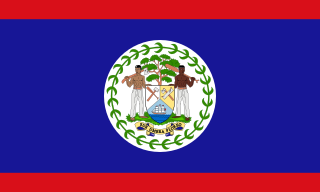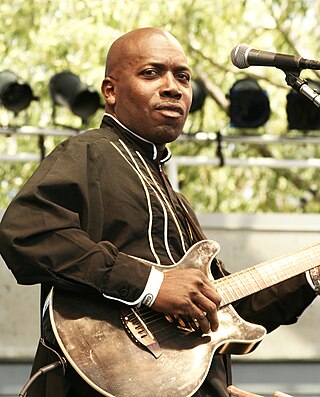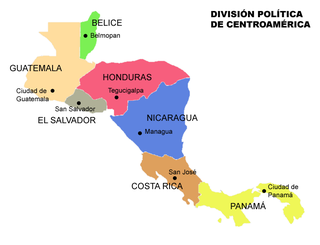Related Research Articles

The music of Belize has a mix of Creole, Mestizo, Garìfuna, Mayan and European influences.
The Garifuna people are a people of mixed free African and Amerindian ancestry that originated in the Caribbean island of Saint Vincent and speak Garifuna, an Arawakan language, and Vincentian Creole.
Garifuna music is an ethnic music and dance with African, Arawak, and Kalinago elements, originating with the Afro-Indigenous Garifuna people from Central America and Saint Vincent and the Grenadines. In 2001, Garifuna music, dance, and language were collectively proclaimed as a Masterpiece of the Oral and Intangible Heritage of Humanity by UNESCO.

Zambo or Sambu is a racial term historically used in the Spanish Empire to refer to people of mixed Amerindian and African ancestry. Occasionally in the 21st century, the term is used in the Americas to refer to persons who are of mixed African and Indigenous American ancestry.

Punta rock, or Belizean punta, is a form of Garifuna music originating in Belize and created by Pen Cayetano. Songs are usually sung in Belizean Kriol or Garifuna and rarely in Spanish or English. Many Garifuna American artists and bands perform the genre as well.

Punta is an Afro-indigenous dance and cultural music of the Garifuna originating prior to their exile to Roatan from the Caribbean island of Saint Vincent And The Grenadines. Which is also known as Yurumei. It has African and Arawak elements which are also the characteristics of the Garifuna language. Punta is the best-known traditional dance belonging to the Garifuna community. It is also known as banguity or bunda.

Andy Vivian Palacio was a Belizean punta musician and government official. He was also a leading activist for the Garifuna people and their culture.
Paul Nabor, born Alfonso Palacio, was a Garifuna singer and musician from Punta Gorda, Belize. He is often credited with popularizing paranda, a style of traditional Garifuna music, and is considered to have been one of the most talented musicians of the genre.
Garifuna (Karif) is a minority language widely spoken in villages of Garifuna people in the western part of the northern coast of Central America.
Belizean Creoles, also known as Kriols, are a Creole ethnic group native to Belize.

Central America is a subregion of the Americas formed by six Latin American countries and one (officially) Anglo-American country, Belize. As an isthmus it connects South America with the remainder of mainland North America, and comprises the following countries : Belize, Guatemala, Honduras, El Salvador, Nicaragua, Costa Rica, and Panama.
Belize, on the east coast of Central America, southeast of Mexico, was inhabited by the indigenous peoples who fought off the Spaniards in an attempt to preserve their heritage and to avoid the fate of their neighbors who were conquered and under Spanish rule. While this was going on, British pirates would rob Spanish merchant ships and navigate through the shallow waters and small islands even going up river later to hide their bounty. The indigenous people of Belize did not resist the British like they did the Spanish. In the 17th century, however, the British settlement became a formal British crown colony from 1862 through 1964, where they first achieved self government and later in 1981 became an independent country recognized globally with all its territory intact. The British brought along with them slaves taken from Congo and Angola during the eighteenth century.
The Lebeha Drumming Center was established in 2002 by Jabbar Lambey and Dorothy Pettersen, in Hopkins, Belize. Hopkins is a small coastal Garifuna community in the Stann Creek District of southern Belize. The center exists with the goals of keeping Garifuna music alive, passing traditional music along to young people in the community, and sharing music with visitors to Hopkins. The center’s focus is on traditional percussion music, though guitars have been donated and are also played.

Aurelio Martínez, professionally known as Aurelio, is a Honduran musician and politician. He is a singer, percussionist, and guitarist known for his Garifuna music and is considered a Cultural Ambassador of the Garifuna people. According to the Guardian, he became the leading Garifuna performer after the death of musician Andy Palacio.

Afro-Hondurans or Black Hondurans are Hondurans of Sub-Saharan African descent. Research by Henry Louis Gates and other sources regards their population to be around 1-2%. They descended from: enslaved Africans by the Spanish, as well as those who were enslaved from the West Indies and identify as Creole peoples, and the Garifuna who descend from exiled zambo Maroons from Saint Vincent. The Creole people were originally from Jamaica and other Caribbean islands, while the Garifuna people were originally from Saint Vincent and the Grenadines. Garifunas arrived in the late seventeen hundreds and the Creole peoples arrived during the eighteen hundreds. About 600,000 Hondurans are of Garífuna descent that are a mix of African and indigenous as of Afro Latin Americans. Honduras has one of the largest African community in Latin America.

Umalali is a collaborative project put together by Belizean musician and producer, Ivan Duran. Umalali is defined by the stories that comprise The Garifuna Women's Project.
This is a compilation of traditional dances from Nicaragua.

Garifuna in Peril is a low-budget independent fiction docufiction feature film directed, written, and produced by Alí Allié and Rubén Reyes. The film depicts historical and contemporary issues within the Garinagu Afro-Honduran indigenous community and features a cast of actors from Honduras and Belize.

Paranda is both a Garifuna rhythm and music with Arawak and African elements which utilizes rhythmic ostinatos in duple meter. Similar to punta, the paranda is a slower rhythm than punta. Paranda mainly focuses on the struggles that occurs in the Garifuna community. and reflects Spanish influences. Traditionally, the guitar is played in paranda and not in punta. and its melodies are soulful lamentations.
The National Garifuna Council (NGC) of Belize is a non-governmental organization that represents the Garifuna people of Belize. Their mission is to preserve, strengthen, and develop the Garifuna culture, as well as to promote economic development, interracial harmony among the Garifuna people, and maintain traditional respect for preserving the environment. It was established in 1981 and is managed by a board of directors with corresponding branches in Guatemala, Honduras, and Nicaragua. These countries all share the unique Garifuna culture, as they all served as refuge to the Garifuna people when they were exiled from their homeland, St. Vincent.
References
- ↑ Professor Angel Batiz Mejia, quoted in Barauda brings traditional Garifuna dances to Teguz , Honduras This Week, March 30 1998. Archived 2012-02-04 at the Wayback Machine